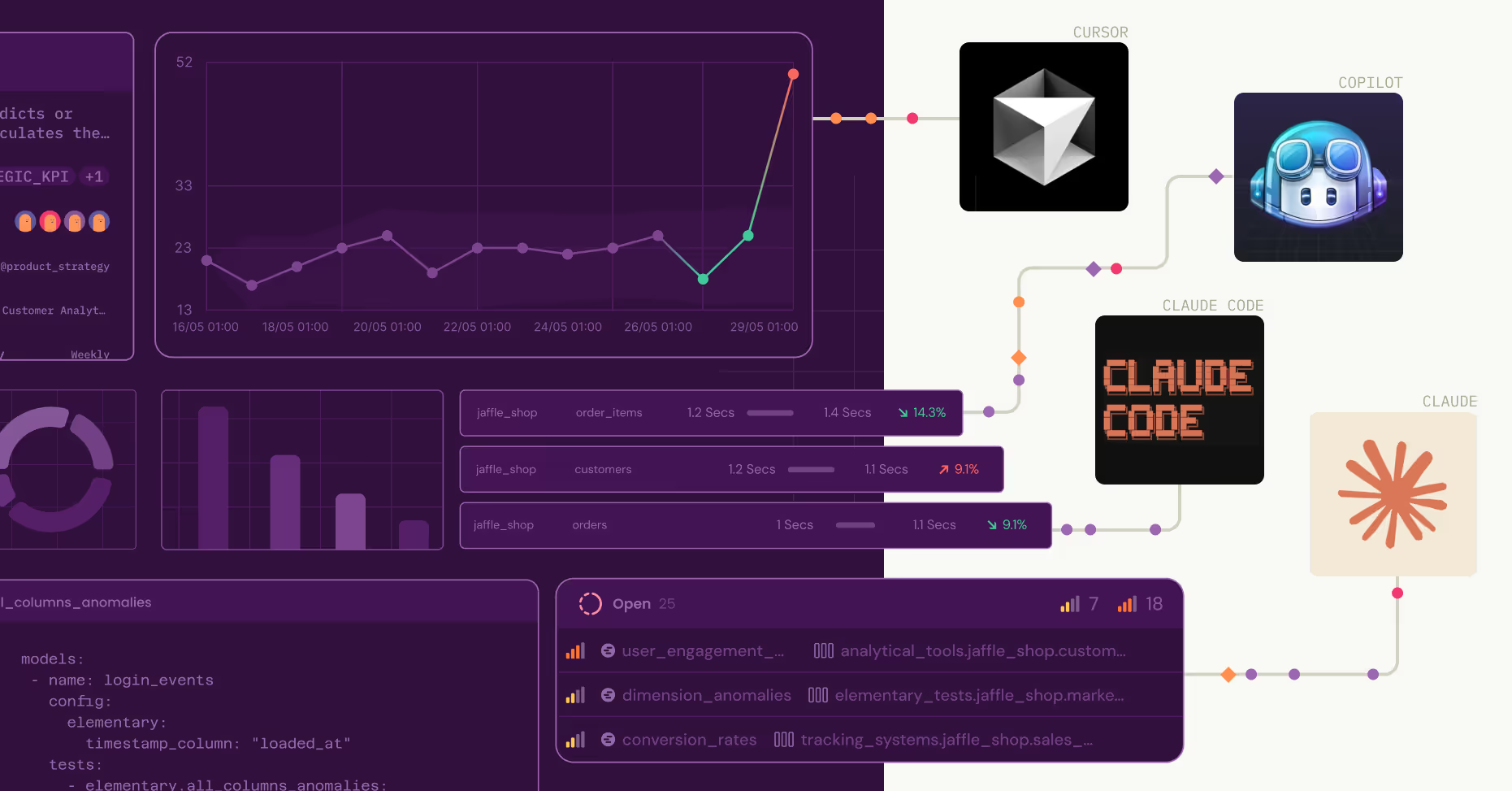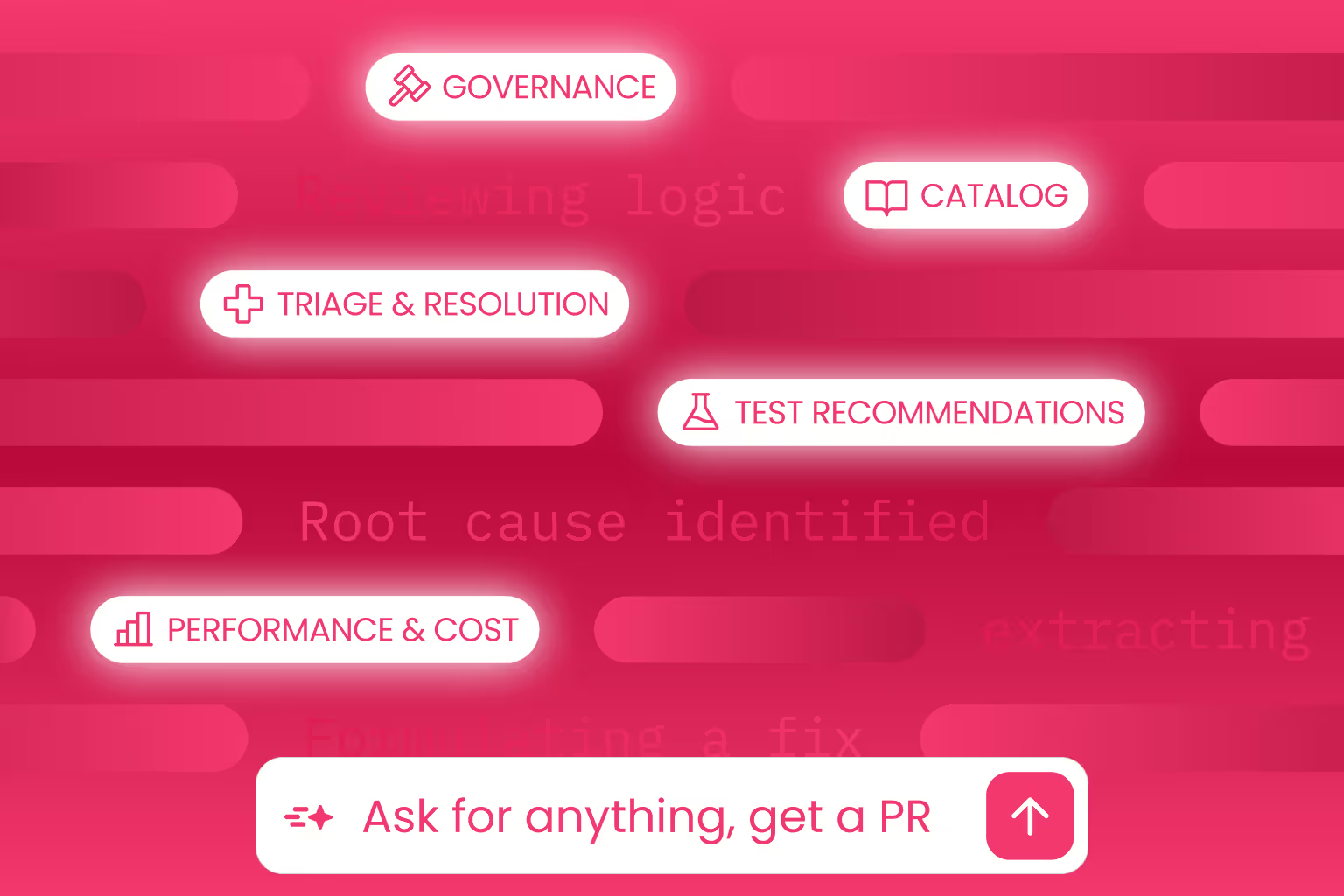TL;DR
- Elementary MCP Server exposes metadata, lineage, test coverage, and incidents to LLMs and AI agents.
- Engineers can see downstream impacts, generate missing tests, and refactor automatically in their IDE.
- Analysts can validate data health, lineage, and incidents before using the data.
- Enables AI‑native data reliability without switching tools.
--
At Elementary, our mission is simple: make data reliability effortless, automated, and accessible.
- Engineers can build reliability directly into dbt projects and pipelines.
- Analysts and data scientists can trust that data is tested, validated, and understand its lineage at a glance.
Our AI agents have seen fast adoption across data teams, and the first follow‑up request was clear:
“Can we use this intelligence directly in the tools we already work in?”
And of course, the answer was yes.
With LLM‑based assistants, AI‑centric IDEs like Cursor, and embedded copilots in Snowflake or Looker becoming daily workflows, teams need direct access to Elementary’s capabilities without switching context.
That’s exactly what the Elementary MCP Server delivers.
What Is MCP?
MCP (Model Context Protocol) is an open standard introduced by Anthropic in 2024 that allows AI systems to dynamically retrieve relevant context, data, and trigger actions from external tools.
Instead of relying on static integrations or brittle API calls, MCP:
- Exposes live application context (metadata, test results, lineage, etc.)
- Standardizes access for AI models using JSON-RPC
- Makes assistants more capable by grounding them in your real data environment
What does the Elementary MCP Server do?
The Elementary MCP Server acts as a bridge between your Elementary environment, including metadata, tests, column-level lineage, usage stats, BI tools, incidents, test coverage, and data health, and any MCP-enabled client, such as:
- Cursor
- Claude Desktop
- Agent frameworks and internal copilots
It provides access to a set of tools that operate on top of your Elementary environment, allowing LLMs and copilots to query incidents, data health, column-level lineage, tests, and metadata directly (by the way, these are the same tools we use to power our own AI Agents).
This means you can query and act on your data stack using natural language, directly from your AI environment, with no custom integration work.

These are the primary functions of the MCP server available today.
Data Discovery & Full Lineage
Provides comprehensive asset discovery and data lineage capabilities across the entire data pipeline. Users can explore relationships between assets (upstream / downstream dependencies), investigate both asset-level and column-level lineage, access detailed asset metadata, view compiled queries, track execution history, and understand how different assets are used through queries, consumption patterns, and operational metrics like row counts, freshness updates, and table update times. This category covers everything from understanding data flow and dependencies to debugging execution issues and assessing change impact.
Tests & Coverage
Enables complete test management and data quality monitoring throughout the data pipeline. Users can discover existing tests, analyze test coverage across assets, investigate test configurations and results, review historical test performance, and access detailed execution metrics including anomaly detection. This category helps prioritize testing efforts, debug quality issues, and maintain comprehensive data quality coverage.
Incidents & Data Health
Provides incident management and investigation capabilities for data quality issues, plus comprehensive data health monitoring. Users can search and filter incidents, investigate specific incident details including root cause analysis, and review historical incident patterns for assets. This category enables proactive incident response, trend analysis, and continuous improvement of data reliability.
What is currently included in Elementary’s MCP server
A suite of MCP tools, including:
- Test results and anomalies
- Assets metadata
- Comprehensive lineage - from source to BI and column-level
- Test catalog
- Health scores and incident status
You can use these tools to:
- Query metadata from tools like Claude,
- Power agents that explain issues, suggest fixes, or validate tables
- Integrate with tools like dbt-MCP and Cursor IDE to bring reliability into your dev workflow
With the Elementary MCP Server, AI agents and copilots can access trusted observability context without raw data access or manual scripts.
Check out the full list of tools available with the MCP Server.
To get started, check out the MCP Server setup guide.
Lets walk through a few example workflows:
Using the Elementary MCP Server for Test Coverage
Elementary continuously tracks test results, coverage, and gaps across your pipelines. Through the Elementary MCP Server, this context is accessible to LLMs and AI agents, allowing engineers to both understand gaps and create new tests—all without leaving their IDE.
Example workflows:
Discover coverage gaps by asking questions like:
- “Which models are missing freshness tests?”
- “Show me all tables without schema tests.”
- “Which data products have low test coverage?”
- “Which key metric tables aren’t fully monitored?”
- Your AI agent uses Elementary’s MCP tools to instantly map gaps and prioritize critical assets.
Generate tests automatically:
- From the same IDE session, your AI agent can generate the missing tests (freshness, schema, anomaly) and insert them into the dbt project.
- The agent leverages column‑level lineage and asset metadata to ensure tests are applied correctly and consistently.
Using the Elementary MCP Server for Discovery
Elementary maintains a live, unified view of your data platform, including tables, sources, column-level lineage, incidents, test coverage, and health scores. The Elementary MCP Server exposes this context to LLMs and AI agents, enabling powerful discovery and automated refactoring.
Data consumers can ask natural language questions like:
- “Which tables power our revenue dashboards?”
- “Show me all dashboards that rely on the marketing spend model.”
- “Which columns are critical for revenue reporting?”
For Data & Analytics Engineers:
Imagine needing to rename a column with 150 downstream dependencies. Manually refactoring this is nearly impossible. Now, an engineer can use Elementary’s discovery tools via an AI agent in their IDE to:
- Automatically retrieve full column-level lineage.
- Identify every affected model, test, and dashboard.
- Execute the refactor safely and consistently across all dependencies.
Using the Elementary MCP Server for Health and Incidents
Elementary continuously monitors your data stack—tracking failed tests, anomalies, health scores, and open incidents with full lineage and impact context. Through the Elementary MCP Server, this information becomes directly accessible to LLMs and AI agents, allowing issues to be surfaced, understood, and resolved where people already work.
Key use cases:
- Data consumers can instantly check if the assets they rely on are healthy, see any open incidents, and confirm that quality scores meet trust thresholds, without leaving their BI tools.
- ASKQL and analytics agents can automatically evaluate data reliability before answering a query. If quality is low or incidents are open, the agent can respond appropriately or avoid returning unreliable insights.
- Engineers receiving an alert can skip the manual investigation. An AI agent in their IDE can pull full incident context via MCP—including the affected assets, lineage, and likely root cause, and immediately guide or execute the fix.
The result is faster resolution, fewer escalations, and trusted data flowing to business users and AI applications alike.
Prevent Issues Before They Happen
Beyond the workflows detailed above, the Elementary MCP enables a new capability - prevention. It enables engineers to catch and prevent downstream breakages during development, before they ever hit production. Here are a few examples:
1. Column Changes and Refactors
You rename or refactor a column in a core model.
- MCP in your IDE immediately surfaces all downstream models, dashboards, and metrics that rely on that column.
- You can update dependencies before merging, preventing silent errors.
2. Table Logic Updates
You change the SQL logic for a table without knowing who depends on it.
- The MCP Server provides table‑ and column‑level lineage across dbt and BI tools.
- Your agent shows who is using this data and what will break, letting you coordinate before deploying.
3. Volume and Data Integrity Shifts
Your code change would drop a table from 1,000,000 rows to 100,000 rows.
- Use MCP to check the historical volume pattern and flag an anomaly if there is a significant drop in row count.
- The agent shows exactly which models and dashboards are at risk, so you can test, adjust, or roll back before production.
Where We’re Seeing Adoption
Early adopters are integrating the Elementary MCP Server into two key areas:
Development Workflows
- Query model health, lineage, and incidents directly from IDEs or notebooks
- Validate code changes without switching context
Consumption Workflows
- Embed data health, lineage, and ownership into BI platforms and internal copilots
- Give business users confidence without back-and-forth with the data team
Roadmap: AI-Native Reliability
There is more to come. We’re already working on:
- Full data health views and test coverage via MCP
- Volume and freshness metrics for dbt models and sources
- Triggering syncs and test runs on demand
The Elementary MCP Server is the first step toward AI‑native data reliability. Soon, copilots and agents will not just report on data health, they’ll proactively monitor, validate, and even self‑correct your pipelines. With full test coverage, lineage, volume and freshness metrics, and automated orchestration available via MCP, reliability becomes embedded everywhere your team works, from IDEs to BI tools to AI assistants.
By bringing context to every interface -code, UI, and AI, we help data teams stay proactive and efficient without leaving their natural workflows.
FAQ
What is Model Context Protocol (MCP) and why does it matter for data teams?
MCP is an open standard that lets AI agents and LLMs access live context, metadata, and trigger actions from external tools. For data teams, this allows copilots to use lineage, test results, and incidents directly in their workflows.
How does MCP improve data reliability and observability?
By exposing test results, lineage, incidents, and asset health to AI agents, MCP enables copilots to detect issues, explain root causes, and prevent downstream breakages directly in the workflows where engineers and analysts work.
What is the Elementary MCP Server?
It’s a bridge between Elementary’s observability data—lineage, test coverage, incidents, and health—and any MCP‑enabled AI agent or copilot, enabling proactive monitoring and automated fixes without switching tools.
How do I set up the Elementary MCP Server?
To get started, check out our MCP Server setup guide.
Can MCP be used with dbt and cloud warehouses?
Yes. Elementary’s MCP Server works with dbt metadata and tests, exposing lineage and health context for assets in Snowflake, BigQuery, Databricks, and similar cloud data platforms.
What are real examples of using the Elementary MCP Server?
- Engineers can see the downstream impact of a column change and auto‑refactor dbt models.
- Analysts can confirm asset health and check for incidents before using dashboards or metrics.
- AI copilots can detect low‑quality data and prevent unreliable answers to business users.



.svg)


